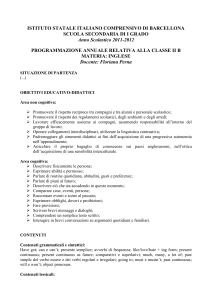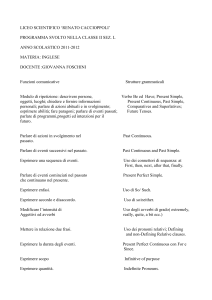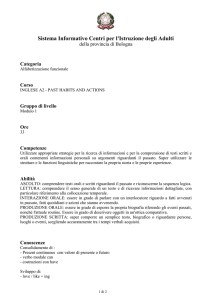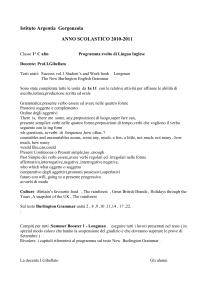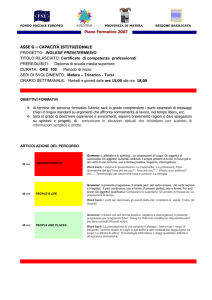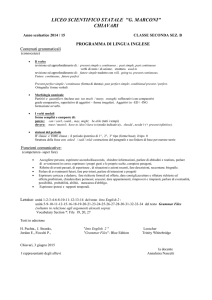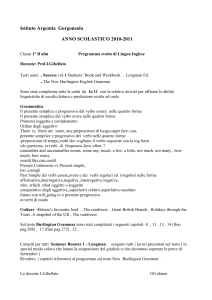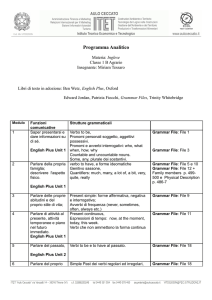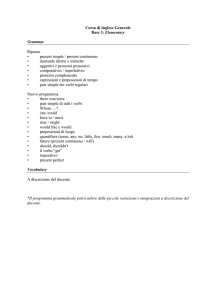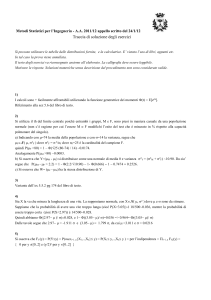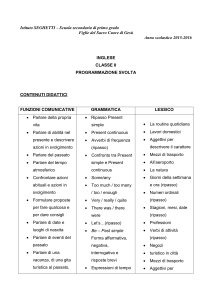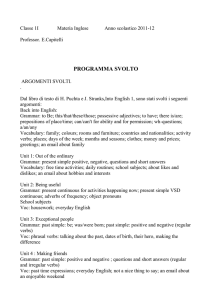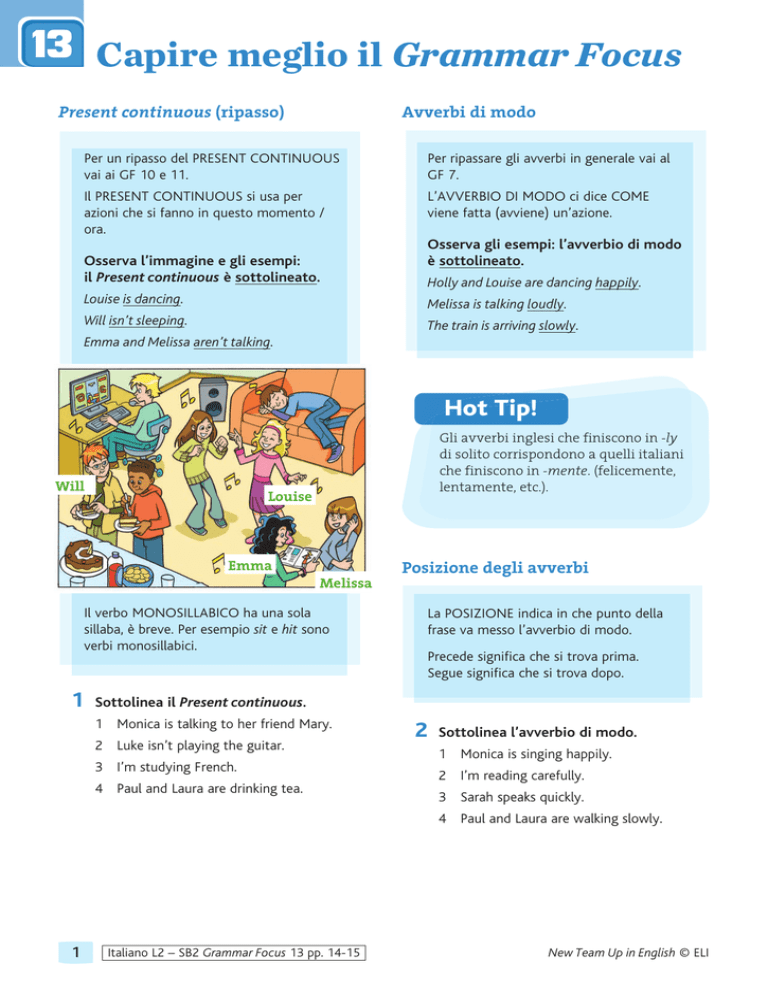
13 Capire meglio il Grammar Focus
Present continuous (ripasso)
Avverbi di modo
Per un ripasso del PRESENT CONTINUOUS
vai ai GF 10 e 11.
Per ripassare gli avverbi in generale vai al
GF 7.
Il PRESENT CONTINUOUS si usa per
azioni che si fanno in questo momento /
ora.
L’AVVERBIO DI MODO ci dice COME
viene fatta (avviene) un’azione.
Osserva l’immagine e gli esempi:
il Present continuous è sottolineato.
Osserva gli esempi: l’avverbio di modo
è sottolineato.
Holly and Louise are dancing happily.
Louise is dancing.
Melissa is talking loudly.
Will isn’t sleeping.
The train is arriving slowly.
Emma and Melissa aren’t talking.
Hot Tip!
Will
Gli avverbi inglesi che finiscono in -ly
di solito corrispondono a quelli italiani
che finiscono in -mente. (felicemente,
lentamente, etc.).
Louise
Emma
Melissa
Il verbo MONOSILLABICO ha una sola
sillaba, è breve. Per esempio sit e hit sono
verbi monosillabici.
Posizione degli avverbi
La POSIZIONE indica in che punto della
frase va messo l’avverbio di modo.
Precede significa che si trova prima.
Segue significa che si trova dopo.
1 Sottolinea il Present continuous.
1 Monica is talking to her friend Mary.
2 Luke isn’t playing the guitar.
3 I’m studying French.
4 Paul and Laura are drinking tea.
2 Sottolinea l’avverbio di modo.
1 Monica is singing happily.
2 I’m reading carefully.
3 Sarah speaks quickly.
4 Paul and Laura are walking slowly.
1
Italiano L2 – SB2 Grammar Focus 13 pp. 14-15
New Team Up in English © ELI
14 Capire meglio il Grammar Focus
Present simple e azioni abituali
Un’azione è abituale quando si ripete più
volte con regolarità.
Avverbi di frequenza (ripasso)
Per il ripasso degli avverbi di frequenza vai
al GF 7.
Osserva gli esempi di azioni abituali.
I go to school every day.
They often go to the cinema at weekends.
Fare proposte (ripasso)
Dare un consiglio significa dire a qualcuno
cosa deve fare secondo te.
Fare una proposta significa invitare
qualcuno a fare qualcosa insieme.
She always plays tennis on Saturdays.
Present continuous e azioni in corso
di svolgimento
Osserva gli esempi: le espressioni
inglesi per dare consigli o proporre
qualcosa sono sottolineate.
A I’m bored.
B Why don’t you go for a walk? (consiglio)
A I’m hungry.
Un’azione è in corso di svolgimento quando
viene fatta nel momento in cui si parla. Non
è generica, STA SUCCEDENDO ORA.
Osserva gli esempi di azioni in corso di
svolgimento.
B Let’s eat a pizza! (proposta)
2 Sottolinea i consigli e cerchia le
proposte.
It’s raining! I can’t go out.
1 Let’s watch a film.
Look! There is Carol! She is going to school.
2 Why don’t you take an umbrella?
3 Let’s go to Mary’s party tonight.
4 Why don’t you drink something if you
are thirsty?
Where is Sam?
He’s reading a newspaper at the moment.
1 Sottolinea le azioni abituali e cerchia
quelle in corso di svolgimento.
1 I play the piano every day.
2 What are you doing? I’m writing a letter.
3 They are doing their homework.
4 We often go to the mountains in winter.
1
Italiano L2 – SB2 Grammar Focus 14 pp. 22-23
New Team Up in English © ELI
15 Capire meglio il Grammar Focus
To be – Past simple
Il PASSATO è un tempo dei verbi e si usa
per parlare di cose che sono già successe.
Osserva gli esempi: il verbo al
presente è sottolineato, quello al
1 one
6 six
passato è cerchiato .
7 party!
seven(now)
There are a2 lot two
of people at the
I NUMERI ORDINALI sono quelli che
danno un ordine alle cose (es. primo,
secondo, terzo…).
Osserva i seguenti numeri ordinali.
1st
2nd second
3 a lot
three
8 theeight
There were
of people at
party!
(yesterday,
week…)
4 lastfour
9 nine
five tempi diversi
10 ten
In italiano5si usano
a seconda
di quando è successa l’azione:
• l’imperfetto (andavo)
• il passato prossimo (sono andato)
• il passato remoto (andai)
Se l’azione è FINITA, CONCLUSA, in
inglese si usa sempre il Past simple (went).
1 Sottolinea il verbo al presente e cerchia
quello al passato.
first
3rd
third
6th sixth
7th seventh
8th eighth
4th fourth
9th ninth
5th fifth
10th tenth
In inglese si usano:
i numeri ORDINALI per le DATE.
i numeri CARDINALI per gli ANNI.
Osserva gli esempi: i numeri ordinali
sono sottolineati, quelli cardinali
cerchiati .
2nd June
2008
1976
18th November
1 Last year I was in China.
2 Where do you live? I live in Italy.
3 Giacomo Leopardi was an Italian poet.
Espressioni di tempo
4 Are there a lot of parks in your town?
Le espressioni di tempo indicano
QUANDO è successa un’azione.
La data (ripasso)
I NUMERI CARDINALI sono quelli che
usiamo per CONTARE (es. uno, due, tre…).
Osserva i seguenti numeri cardinali.
I wasn’t at home yesterday.
Last month it was summer.
4 weeks
ago I was on holiday!
1st first
6th sixth
1
one
6
six
2
two
7
seven
3
three
8
eight
eighth
third
8
3
2 Sottolinea
le espressioni
di tempo.
4
four
9
nine
1 4I thwasfourth
born 30 years
ninth
9th ago.
5
five
10
ten
th
2 5Yesterday
at school.
fifth they weren’t
10th tenth
3 Last week she was ill.
Vai al PT Pictionary, scheda 1: Numbers,
Colours and Shapes per vedere l’elenco dei
numeri da 1-1,000,000,000.
1
Osserva gli esempi: le espressioni di
tempo sono sottolineate.
Italiano L2 – SB2 Grammar Focus 15 pp. 30-31
2nd second
rd
7th seventh
th
4 Where were you 3 minutes ago?
New Team Up in English © ELI
16 Capire meglio il Grammar Focus
Past simple – verbi regolari
1 Sottolinea il Past simple.
1 He didn’t live in the countryside.
Vai al GF15 per un ripasso del PASSATO.
2 They travelled by train.
I VERBI REGOLARI sono quelli che seguono
sempre la stessa regola di formazione
per formare il Past simple i verbi
regolari aggiungono sempre -d / -ed.
3 What did you study yesterday?
La DESINENZA indica una o più lettere che
si aggiungono alla fine di una parola
-d / -ed sono desinenze.
Osserva gli esempi: il Past simple dei
verbi regolari è sottolineato.
She visited Paris last summer.
We didn’t play cards.
4 Did Sarah and Jacob listen to your new
CD?
L’AUSILIARE è un verbo di ausilio = di
aiuto, che serve a formare alcuni tempi
verbali. Nei seguenti esempi l’ausiliare è
sottolineato.
Do you go to school every day?
Yes, I do.
I don’t know her.
Did Lucy like Rome?
They didn’t like the film.
I carried a big suitcase.
Did he paint a picture yesterday?
Una VARIAZIONE ORTOGRAFICA è
il cambiamento di una o più lettere
all’interno di una parola.
Le lettere si possono:
• aggiungere
• togliere
• possono cambiare
stop
stopped (si aggiunge una ‘p’ =
la ‘p’ raddoppia)
carry
carried (la ‘y’ diventa ‘i’)
2 Sottolinea l’ausiliare.
1 He didn’t live in the countryside.
2 No, I didn’t.
3 What did you study yesterday?
4 Did Sarah and Jacob listen to your new
CD?
Un verbo è BISILLABICO quando ha 2
sillabe, cioè si può dividere in 2 parti (in
base a come lo scrivi in italiano, in base a
come lo pronunci in inglese).
prefer è bisillabico
1
pre-fer
Italiano L2 – SB2 Grammar Focus 16 pp. 40-41
New Team Up in English © ELI
17 Capire meglio il Grammar Focus
Past simple – verbi irregolari
Vai al GF15 per un ripasso del PASSATO.
I VERBI IRREGOLARI sono quelli che
non seguono sempre la stessa regola di
formazione
per formare il Past simple cambiano.
Ognuno ha una forma diversa.
Osserva gli esempi di alcuni Past
simple di verbi irregolari.
go
went
do
did
eat
ate
I verbi irregolari e i verbi regolari si
formano allo stesso modo alla forma
interrogativa e negativa.
1 Sottolinea il Past simple.
1 I went to Rome by plane last week.
2 She sent me a postcard.
3 I didn’t take a lot of photos.
4 When did you meet Sarah?
2 Indica se i verbi al Past simple sono
regolari (R) o irregolari (IR).
IR I bought a map yesterday.
R I walked to a castle on Saturday.
1
1
We swam in the sea.
2
We stayed up late last night.
3
Alex got up early this morning.
4
They met in Paris last summer.
Italiano L2 – SB2 Grammar Focus 17 pp. 48-49
New Team Up in English © ELI
18 Capire meglio il Grammar Focus
Domande con How + aggettivo
Vai al GF1 per un ripasso delle PAROLE
INTERROGATIVE.
Vai al GF4 per un ripasso dell’AGGETTIVO.
How seguito da un aggettivo significa
‘quanto’.
Osserva la tabella.
La direzione
La DIREZIONE indica il posto dove voglio
andare e l’INDICAZIONE STRADALE è la
strada che devo seguire per arrivare in quel
posto.
Usa l’IMPERATIVO (vai al GF6 per un
ripasso) per dare le indicazioni stradali
(= per dire a qualcuno come arrivare in un
posto).
How old…?
Quanto vecchio?
How tall…?
Quanto alto? (di persone)
How high...?
Quanto alto? (in generale)
Osserva gli esempi: le domande
sulla direzione sono sottolineate e le
indicazioni cerchiate .
How long…?
Quanto lungo?
A Can you tell me the way to the hospital?
________________
Quanto lontano?
B Go straight ahead .
________________
Quanto largo?
A Where is the cinema?
How deep…?
Quanto profondo?
B Turn left at the traffic lights.
How heavy…?
Quanto pesante?
A Can you tell me where the park is?
Osserva gli esempi: how + aggettivo è
sottolineato.
How wide is the river Po?
How old are you?
How tall is your sister?
1 Sottolinea how + aggettivo.
1 How long is the river Thames?
2 How deep is this lake?
B Take the second road on the right.
2 Sottolinea le domande sulla direzione e
cerchia le indicazioni.
1 Can you tell me the way to the railway
station?
2 Where is the church?
3 Go straight ahead.
4 Turn right at the roundabout.
3 How heavy is this parcel?
4 How tall is your friend?
1
Italiano L2 – SB2 Grammar Focus 18 pp. 56-57
New Team Up in English © ELI
18
Preposizioni di moto
Le PREPOSIZIONI sono piccole parole
usate per collegare due elementi (parti)
di una frase.
I walk over the bridge.
preposizione.
over è una
La parola MOTO significa MOVIMENTO.
Osserva gli esempi: le preposizioni di
moto sono sottolineate.
Go past the bank.
Go down the road.
Go into the room.
Go along this street.
3 Sottolinea le preposizioni di moto.
1 Walk along this road.
2 Go into the park.
3 Walk past the cinema.
4 Go along Regent Street.
New Team Up in English © ELI
Italiano L2 – SB2 Grammar Focus 18 pp. 56-57
2
19 Capire meglio il Grammar Focus
Comparativo di maggioranza
COMPARARE significa mettere a confronto
(paragonare) due cose, due persone, etc.
Il comparativo di maggioranza dice che
una cosa o una persona ha qualcosa in PIÙ
dell’altra, dice che una cosa è MAGGIORE
dell’altra.
John is taller than Lucy.
John è più alto di Lucy.
Nell’esempio Lucy è il secondo termine di
paragone, cioè la seconda persona (o cosa)
paragonata alla prima. In inglese è
preceduto da than.
Comparativo di uguaglianza
Il comparativo di uguaglianza ci dice che
una cosa o una persona è come l’altra,
UGUALE all’altra.
Osserva gli esempi: il comparativo di
uguaglianza è sottolineato.
I’m as tall as my brother.
(sono alta tanto quanto mio fratello)
This jacket is as expensive as the red one.
(questa giacca è tanto costosa quanto
quella rossa)
AS … AS corrisponde a TANTO …
QUANTO in italiano.
Premettere significa mettere davanti.
Osserva gli esempi: il comparativo di
maggioranza è sottolineato.
He’s taller than José.
2 Sottolinea il comparativo di uguaglianza.
1 He was always as cheerful as everybody.
She’s more optimistic than her brother.
2 This jacket is as cheap as the red one.
They’re better tennis players than their
friends.
3 Their house is as big as ours.
Today the weather is worse than yesterday.
4 I feel as good as yesterday.
1 Sottolinea il comparativo di
maggioranza.
1 He was always more cheerful than
everybody.
2 This jacket is cheaper than the red one.
3 Their house is bigger than ours.
4 I feel better than yesterday.
1
Italiano L2 – SB2 Grammar Focus 19 pp. 66-67
New Team Up in English © ELI
20 Capire meglio il Grammar Focus
Superlativo di maggioranza
Il superlativo di maggioranza dice che
tra una serie di cose o persone una in
particolare è la più alta, la più simpatica,
la più grande, etc.
Si chiama superlativo RELATIVO di
maggioranza perché si riferisce solo a una
serie limitata (relativa) di cose o persone.
ESSERE PRECEDUTO significa avere
davanti.
Il superlativo di maggioranza in inglese ha
sempre davanti l’articolo the.
Osserva gli esempi: il superlativo di
maggioranza è sottolineato.
Pronomi possessivi
I pronomi possessivi dicono di chi è
qualcosa.
Osserva la tabella e gli esempi:
i pronomi possessivi sono sottolineati.
Aggettivi
possessivi
Pronomi
possessivi
It’s my album.
It’s mine.
It’s your album.
It’s yours.
It’s his album.
It’s his.
It’s her album.
It’s hers.
They’re our albums.
They’re ours.
They’re your albums.
They’re yours.
They’re their albums.
They’re theirs.
Oslo is the most expensive city in the world
John is the tallest in his classroom
This photo album is ours.
In Italy you can eat the best pizza!
Your house is smaller than theirs.
My room is as nice as hers.
1 Sottolinea il superlativo di maggioranza.
N.B. Il pronome possessivo riferito alla
terza persona singolare per animali e cose
(it) non esiste = non c’è.
2 Sottolinea i pronomi possessivi.
1 This book is mine.
2 Those shoes are yours.
1 I think Spain is the best place for a
summer holiday.
3 Is that skirt hers?
4 These things are ours.
2 The Coliseum is one of the oldest
monuments in the world.
3 What is the most difficult subject at
school?
4 This is the worst film of the year.
1
Italiano L2 – SB2 Grammar Focus 20 pp. 74-75
New Team Up in English © ELI
21 Capire meglio il Grammar Focus
Past continuous
Tutte le forme
Il PAST CONTINUOUS corrisponde
all’italiano stavo facendo, stavo andando
(ma in italiano possiamo usare anche
l’imperfetto: facevo, andavo…).
Osserva gli esempi: il Past continuous
è sottolineato.
She was sitting next to you.
(Sedeva/stava seduta accanto a te)
He wasn’t wearing jeans.
(Non indossava/stave indossando jeans)
What were you doing?
(Cosa facevi/stavi facendo?)
1 Sottolinea il Past continuous.
Past simple vs Past continuous
IN UN DATO MOMENTO DEL PASSATO
significa in un momento preciso del
passato.
Un’azione è improvvisa quando succede
di colpo, mentre stava succedendo
qualcosaltro.
L’azione interviene = succede mentre ne
stava succedendo un’altra.
… when we found …
(azione improvvisa che interviene)
We were walking …
(azione in corso nel passato)
Se due azioni si svolgono in successione
significa che succedono una dopo l’altra.
Osserva gli esempi: il Past simple
è sottolineato, il Past continuous è
cerchiato .
We were walking in the park when we
found a dog.
What were you doing when I phoned you?
While Martha was cooking dinner I arrived
at home.
2 Sottolinea il Past simple e cerchia
il Past continuous.
1 Were they chatting?
1 I was going to bed when the phone rang.
2 He was sleeping.
2 When you arrived at the station, we were
leaving.
3 What was the actress doing?
4 The director wasn’t talking to the cast.
3 While she was sunbathing it started to
rain.
4 They weren’t singing when the teacher
came in.
1
Italiano L2 – SB2 Grammar Focus 21 pp. 82-83
New Team Up in English © ELI
22 Capire meglio il Grammar Focus
Can – permesso (ripasso)
Osserva gli esempi: il verbo can (chiedere
e dare il permesso) è sottolineato.
Can I go out
Mum?
No, you can’t.
Can/Could – richiesta
Una richiesta è chiedere a qualcuno di fare
qualcosa.
Osserva gli esempi: can/could
(richiesta) sono cerchiati .
Can you close the window, please?
(meno formale)
Could you teach me how to play?
(più formale)
2 Sottolinea could (possibilità) e cerchia
could (richiesta).
1 Could you pass me the salt, please?
2 I could go home.
In queste frasi il verbo can significa POTERE.
Concedere il permesso di fare qualcosa
significa dire a qualcuno che la può fare.
Osserva la vignetta: la mamma non concede
(= dà) il permesso.
Quando invece la mamma dà il permesso
dice: Yes, you can.
1 Sottolinea il permesso o il divieto di fare
qualcosa.
1 She can play the guitar.
2 Can we go to the concert this weekend?
3 You can’t go out. It’s too cold.
3 They could study more.
4 Could she call me later?
Must e Mustn’t
Un DIVIETO significa che NON SI DEVE
fare una cosa.
Un OBBLIGO è l’ORDINE di fare una cosa.
SI DEVE fare.
Osserva gli esempi: l’ORDINE (must)
è sottolineato; il DIVIETO (mustn’t) è
cerchiato .
You must pay to take a moped test.
You mustn’t eat in the library.
4 They cannot ski.
Could – possibilità
3 Sottolinea l’ordine e cerchia il divieto.
1 You mustn’t eat too much chocolate.
2 You must make your bed.
Osserva gli esempi: could (possibilità)
è sottolineato.
David could teach us how to play chess.
3 You must wash your hands before lunch.
4 You mustn’t ride a moped without
a helmet.
Could we join a kick-boxing club?
1
Italiano L2 – SB2 Grammar Focus 22 pp. 92-93
New Team Up in English © ELI
23 Capire meglio il Grammar Focus
Indefiniti composti
Il verbo get
Gli indefiniti indicano una quantità
generica e non precisa riferita a persone,
cose, luoghi…
Si dicono composti quelli formati dagli
indefiniti:
some
any
every
no
+
body/one
persone
thing
cose
where
luoghi
La lingua informale è quella che si parla
tutti i giorni fra famigliari e amici.
Assumere il significato = prendere / avere
il significato.
Il verbo get seguito da aggettivo o
participio passato spesso in italiano si
traduce con verbi riflessivi.
I verbi riflessivi sono quelli che riflettono
l’azione sulla persona che la fa.
pettinarsi
pettinare se stessi
Osserva gli esempi: gli indefiniti
composti sono sottolineati.
svegliarsi
svegliare se stessi
We can buy everything.
(possiamo comprare tutto / qualsiasi cosa)
Osserva gli esempi di espressioni
verbali con get.
Has anybody got any ideas?
(qualcuno ha un’idea?)
get lost
perdersi
get tired
stancarsi
I know somebody who’s a DJ.
(conosco qualcuno che è DJ)
get worried
preoccuparsi
get married
sposarsi
There is nothing to do here.
(Qui non c’è niente da fare)
I’ve got an old Superman costume
somewhere.
(Ho un vecchio costume da Superman da
qualche parte)
1 Sottolinea gli indefiniti composti.
Verbi + ing form (ripasso)
Vai al GF12 per un ripasso.
Osserva gli esempi: i verbi + ing form
sono sottolineati.
1 Nobody likes making invitations.
Does anybody like making invitations?
2 Is there anything in the fridge?
I love eating pizza!
3 There’s someone at the door.
4 I want to go somewhere for my holidays.
2 Sottolinea i verbi + ing form.
1 I hate getting up early.
2 She likes going out with her friends.
3 We love playing chess.
4 They don’t like playing football.
They prefer playing video games.
1
Italiano L2 – SB2 Grammar Focus 23 pp. 100-101
New Team Up in English © ELI
24 Capire meglio il Grammar Focus
Futuro con going to
L’intenzione di fare qualcosa significa che
ho in mente di fare quella cosa anche se
non ne sono certo.
In questa forma di futuro cambia solo il
verbo essere.
Osserva gli esempi: il futuro con going
to è sottolineato.
I’m going to write José an e-mail.
Are you going to tell him about the
weather?
They aren’t going to play volleyball.
1 Sottolinea il futuro con going to.
2 Sottolinea il Present continuous
(presente) e cerchia il Present continuous
(futuro).
1 I’m waiting for the bus at the moment.
2 They’re having a cup of tea right now!
3 The train is arriving in ten minutes.
4 I’m getting a new computer next week.
Going to vs Present continuous
going to
intenzione
present continuous
futuro programmato
Osserva gli esempi: il going to
(intenzione) è sottolineato, il Present
continuous (futuro programmato) è
cerchiato .
I’m going to send José an e-mail.
I’ m buying a new car next week.
2 Sottolinea il going to (intenzione) e
1 I’m going to spend my summer on the
beach.
cerchia il Present continuous (futuro
programmato).
2 Is she going to write Lucy?
1 We’re meeting James on Sunday evening.
3 We aren’t going to come to the party.
2 I’m not working tomorrow.
4 They are going to visit her very soon.
3 Are you going to call John?
4 They aren’t going to meet her.
Present continuous – futuro vs presente
Un evento (fatto) è programmato quando è
stato già deciso da tempo.
Osserva gli esempi: il Present
continuous (presente) è sottolineato,
il Present continuous (futuro) è
cerchiato .
We’re writing an e-mail now.
(Stiamo scrivendo una e-mail ora)
I’ m seeing David next month.
(Vedrò David il mese prossimo)
1
Italiano L2 – SB2 Grammar Focus 24 pp. 108-109
New Team Up in English © ELI

